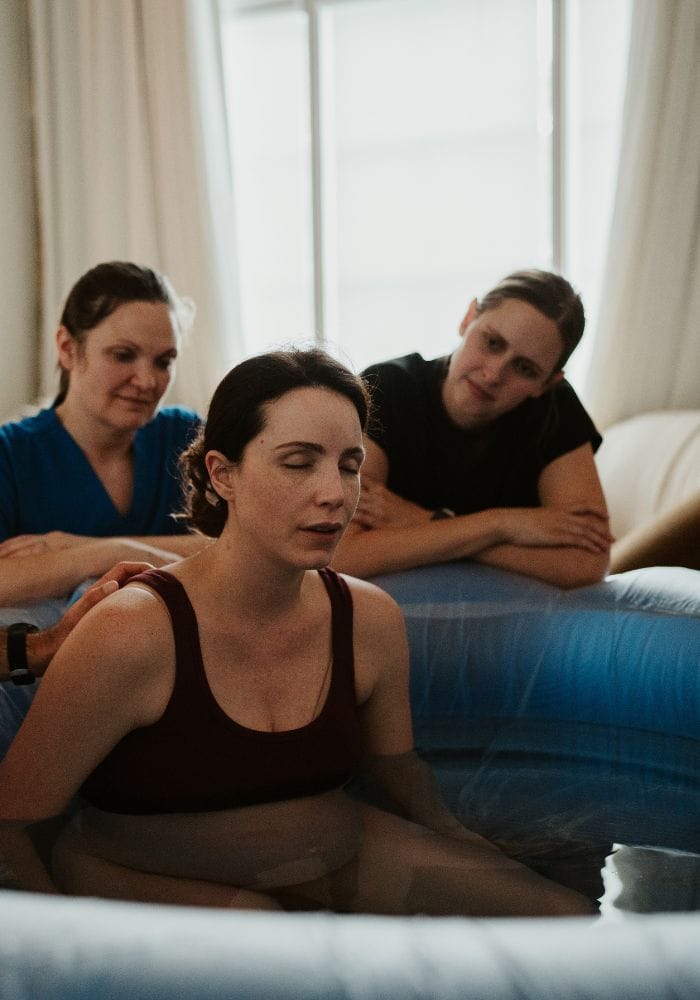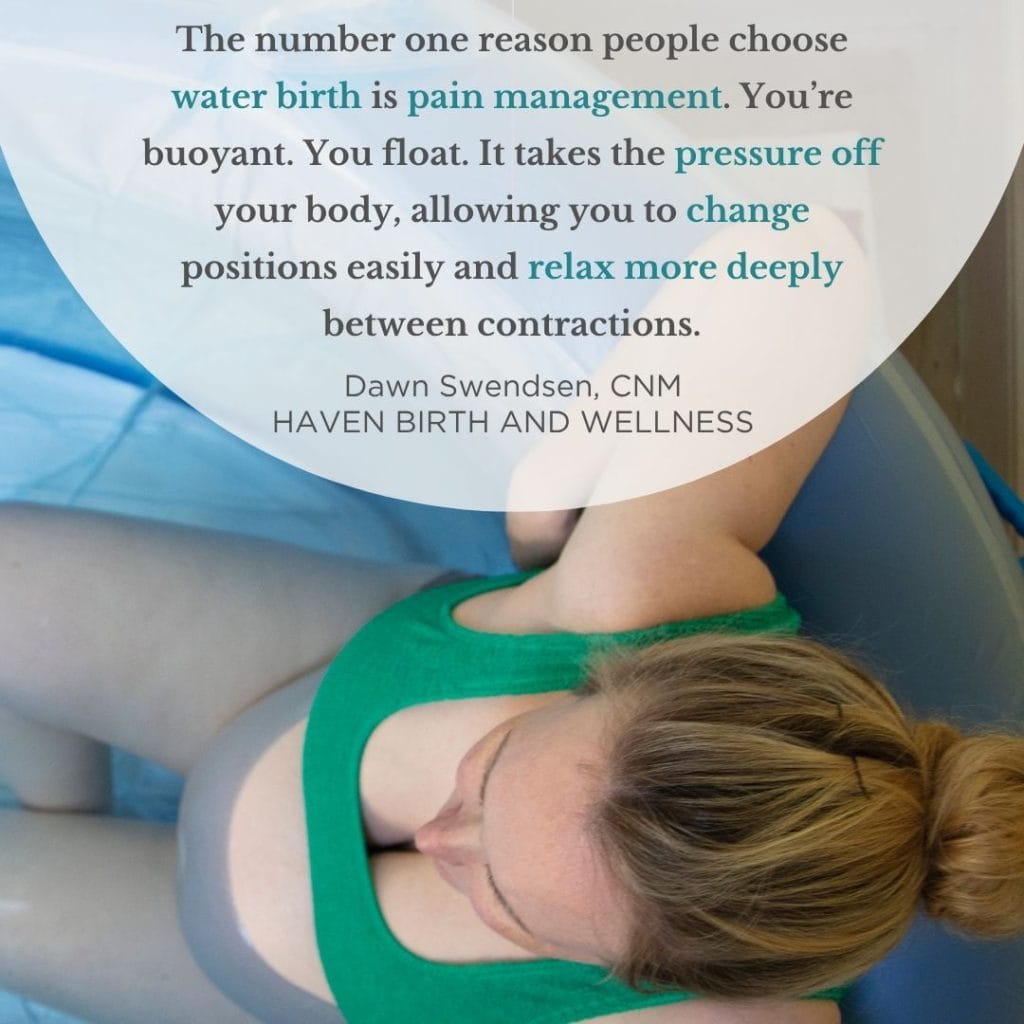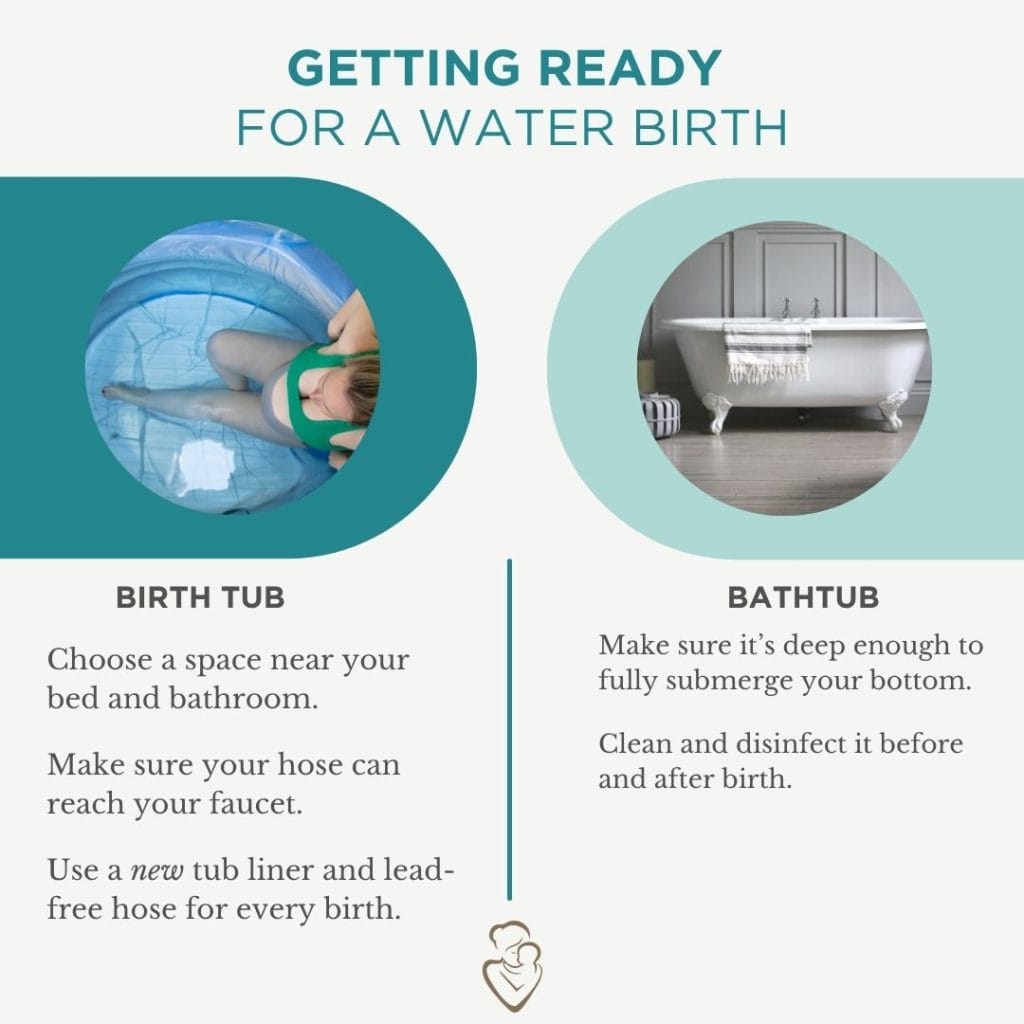

One of the wonderful things about planning a home birth is having the option of a water birth.
Whether you’re curious about the idea or are already picturing yourself in a warm tub, it’s helpful to understand what water birth involves and when it’s the right fit.
Sometimes women ask whether home births have to be water births. The answer is absolutely not! Water birth is often an option, but never a requirement. It’s your body, your birth, and you get to decide what’s right for you.
Where Can You Have a Water Birth?
If you’re considering a water birth, the two most common options are to birth at home or in a birthing center.
Some hospitals allow you to labor in water, but they typically ask you to get out before pushing. I’m not aware of any U.S. hospitals that support actual water birth (I’d love to know if any exist!), though I’ve heard occasional stories of moms laboring quickly and “accidentally” birthing in the water.
Why Choose Water Birth?
The number one reason people choose water birth is pain management. Water provides a kind of relief that’s hard to explain until you experience it. You’re buoyant. You float. It takes the pressure off your body, allowing you to change positions easily and relax more deeply between contractions.
Water births also take advantage of something called the Gate Control Theory of pain. This theory proposes that alternative stimuli — like pleasantly warm water surrounding you — actually decrease your brain’s perception of pain. It’s the same principle behind listening to music or gripping Birth Weapons during labor.
Water sometimes slows labor progress, which might sound counterproductive, but it can actually be helpful in certain circumstances. If you’re having a very long labor, for instance, I might ask you to step into the tub to slow your contractions for a short respite. This way you can rest and recharge before starting again with renewed energy.
This last feature of water birth is why we usually wait until transition, or the end of the first stage of labor, before getting you into a tub. We want to make sure you get the full relief at that hardest point, without slowing your progress beforehand.

When Water Birth Might Not Be the Right Fit
While water birth is wonderful in many circumstances, it isn’t ideal in all situations. In such cases, however, we’d often be transferring care to a hospital system anyway. Examples include:
- Preterm labor: Preterm babies shouldn’t be birthed in water, but if you go into labor before 37 weeks, you’ll be heading to the hospital anyway.
- Thick meconium: If we’re aware of thick meconium ahead of time (like your water breaks before pushing) we’ll likely transfer to the hospital; if it’s discovered during the pushing stage, we may continue in the tub depending on the situation.
- Breech baby: While Haven transfers all breech births to a hospital setting, some midwives do attend vaginal breech births. In these cases, however, birthing in water interferes with visibility and the midwife’s ability to intervene if necessary.
- Excessive bleeding or maternal infection: If you’ve been diagnosed with either, you’ll need to birth out of the water. Uncontrolled bleeding or maternal infections are reasons to transfer to a hospital.
- Preeclampsia (toxemia): If you develop preeclampsia, you’ll need to transfer.
In other cases, I might have to ask moms who start in the tub to get out of the water:
- Bleeding assessment: Since blood disperses in water, I may have to ask you to leave the tub to evaluate how much blood you’re losing.
- Repositioning: If I need to perform a maneuver to help baby emerge, such as in a case of shoulder dystocia, I’ll usually ask you to leave the tub.
- Water temperature: You won’t be able to use the tub if the water temperature drops below 98°F or rises above 101°F.
- Contamination: If the water becomes contaminated, such as with excessive stool during pushing, I’ll encourage you to get out as this is not a great environment to birth your baby
Remember, if your midwife asks you to get out of the water, there’s a reason. We won’t arbitrarily change your plan. We’re there to support you and keep you and your baby safe and healthy.
How to Prepare for a Water Birth
Moms can choose to birth either in their own bathtub or in a birthing tub, so here are our recommendations on how to prepare for each:
Using Your Bathtub
If you’re planning to use your own bathtub, make sure it’s deep (and wide) enough. All of your bottom and vagina must be completely submerged for a water birth. This is crucial to keep air from touching any part of your baby, which could stimulate their breathing reflex before they’re out of the water.
You’ll also need someone to thoroughly clean and disinfect your tub before and after use.
Using an Inflatable Tub
Many women use an inflatable tub for birth, and the bedroom is a common choice for setup if the area allows. It feels like a safe, private space, and if you need to get out of the water, you’re close to your bed and bathroom.
One practical consideration regarding setup location is hose length. Haven’s hoses are 25-feet long and need to reach from your shower or bathtub faucet to the tub. Consider whether you’ll need to purchase a longer hose based on your home’s layout.
Always use a brand new tub liner and a new lead-free hose. Reusing hoses from previous births does not work for hygiene reasons.

Water Birth With Haven
If you’re planning a water birth with Haven, we’ll visit your home around 36 weeks and walk you through setup, logistics, and any questions you have. For those who want an inflatable birthing tub, we provide them to clients free of charge. You can purchase the new liner and hose from us as well.
One of the most common practical questions I get about home water births is about how to clean up. With Haven, all you have to worry about after birth is spending time with your sweet baby. We take care of everything else, including cleaning any soiled laundry from the birth and draining the birthing tub using our handy sump pump.
Is Baby Safe in the Water?
At Haven, babies spend minimal time in the water. Once their head is birthed, we usually see the body follow within a contraction or two. If not, I’ll often have mom stand up to bring baby to the surface.
You might be surprised to see your baby underwater briefly, but remember, they’re not breathing air into their lungs yet. This is completely normal. Then, as soon as your baby is out, we gently guide your newborn into your arms.
Can Mom Stay in the Tub After Birth?
Yes, you can stay in the tub for a little while after birth if you’d like, as long as the water is warm enough and we’re not seeing concerning bleeding. Some moms deliver the placenta in the water; others choose to get out. Either way is okay. If we need to better assess blood loss, we’ll help you move to the bed.
Final Thoughts on Water Birth
Water birth can be a beautiful, comforting way to welcome your baby into the world. If you’re interested in this approach but still aren’t sure, I’d encourage you to talk with your midwife. Ask questions and consider your unique situation and preferences.
And remember, just because you plan a water birth doesn’t mean you’re locked in. You can always change your mind in the moment.
At Haven, our goal is for you to feel safe, supported, and cared for — no matter what your birth looks like. And if you choose a water birth, we’ll be with you every step of the way.

Dawn Swendsen, CNM, MSN, APRN, is a midwife at Haven Birth and Wellness with 25 years of experience in women’s health. She has participated in nearly 1,500 births in diverse settings across the U.S. With a background in Labor and Delivery, NICU, OB-Emergency, and the Main Emergency Department, midwifery became a natural progression for Dawn. She is passionate about empowering women through education and shared decision-making.Originally from the Pacific Northwest, Dawn now lives in Tennessee with her husband, Taylor, and their five children: Ezra, Lucy, Levi, Micah, and Jude. She enjoys running, camping, and outdoor activities.
